![]()
![]()
![]()
Use LEFT and RIGHT arrow keys to navigate between flashcards;
Use UP and DOWN arrow keys to flip the card;
H to show hint;
A reads text to speech;
35 Cards in this Set
- Front
- Back
- 3rd side (hint)
|
Starts at slide 149
|
.
|
|
|
|
Genetic sex is established at =,
|
fertilization
Early genital development is referred to as the = |
indifferent stage of sexual development
|
|
|
the gonads do not begin to attain sexual characteristics until week
|
7
|
|
|
|
the external genitalia do not acquire distinct masculine or feminine characteristics until week =.
|
12
|
|
|
|
*** The gonads (testes and ovaries) are derived from three sources:
|
mesothelium
mesenchyme primordial germ cells. |
|
|
|
***The mesothelium (mesodermal epithelium) lining the
|
posterior abdominal wall
|
|
|
|
*** The underlying mesenchyme (embryonic
|
connective tissue
|
|
|
|
Recall: Primordium : the beginning of an
|
organ or structure
The primordium of upper limb appears as a = |
a bud (Limb bud).
|
|
|
Indifferent Gonads
During the ______ week a thickened area of ________ $ develops on the medial side of the mesonephros. |
5th
mesothelium |
|
|
|
Proliferation of this epithelium and the underlying mesenchyme produces a bulge on the medial side of the mesonephros - the =
|
gonadal ridge/cord.
|
|
|
|
gonadal ridge/cord. comes from = $
|
mesothelium
mesenchyme |
|
|
|
Thickened area of ____________ develops on the medial side of the mesonephros.
|
mesothelium
Proliferation of this epithelium produces a bulge on the medial side of the = |
mesonephros - the gonadal ridge/cord.
|
|
|
Fingerlike
gonadal cords – soon grow into the underlying |
Mesenchyme
The indifferent gonad now consists of an = |
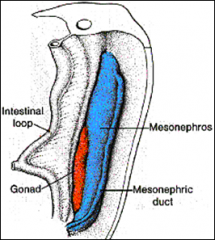
external
cortex and an internal medulla |
|
|
In embryos with an XX sex chromosome complex, the cortex of the indifferent gonad differentiates--- into
|
an ovary and =
|
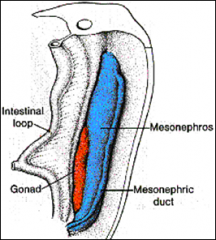
the medulla--- regresses.
|
|
|
In embryos with an XY sex chromosome complex, the medulla--- differentiates into a =
|
testis and the cortex--- regresses, except for =
|
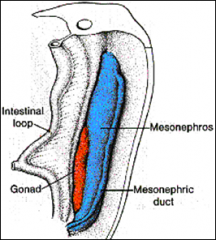
vestigial remnants.
|
|
|
Transverse section through the GC in the __week =
|
8th
pic |

|
|
|
Transverse section of the GC at the __ week
|
7th
pic |
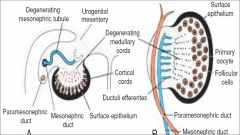
|
|
|
Recall:The gonads (testes and ovaries) are derived from three sources: =
|
The mesothelium,
The underlying mesenchyme, The primordial germ cells) |
|
|
|
The primordial germ cells form in the wall of the yolk sac (endodermal origin) during week =
They later migrate into the developing gonads at week |
4
6 and differentiate into the definitive germ cells-- |
oogonia/spermatogonia
|
|
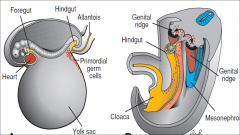
primordial germ cells form in the wall of the
|
yolk sac during week 4.
They later migrate into the developing gonads and differentiate into the = |
definitive germ cells.
|
|
|
Before the ___ week, the gonads of the two sexes are identical in appearance and are called =
|
7th
indifferent gonads |
|
|
|
Development of the male phenotype requires a =
|
Y chromosome
|
|
|
|
The SRY gene for a testis-determining factor (TDF) has been localized in the sex-determining region of the =
|
Y chromosome on the short arm.
|
|
|
|
The ___ gene for a testis-determining factor (TDF) has been localized in the____________________ chromosome on the short arm.
|
SRY
sex-determining region of the Y |
|
|
|
Under the influence of TDF, the gonadal cords differentiate into =
|
seminiferous cords
(primordia of seminiferous tubules) |
|
|
|
absence of a Y chromosome
results in the formation of an |
(i.e., an XX sex chromosome complement)
Testosterone, produced by the fetal testes, determines maleness. |
|
|
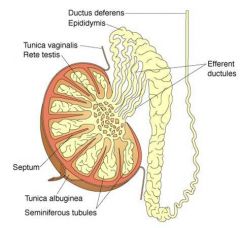
The first step in the development of the testes is the formation of the =
|
tunica albuginea
a layer of fibrous connective tissue which separates the = |
sex cords/Gonadal cord
(now known as seminiferous cords) from the surface epithelium. |
|
|
Within the tunica albuginea, the seminiferous cords are separated from one another by mesenchyme. This mesenchyme will go on to produce the =
|
Leydig cells.
|

|
|
|
_____ _____ are important as they produce
testosterone which travels to receptors in the mesonephric duct. |
Leydig cells
This maintains the presence of these mesonephric ducts (as opposed to the female embryo where the duct degenerates). |
|
|
|
The seminiferous cords also have an important role in male differentiation. The cords are solid (i.e. no lumen) =
|
until puberty
are made up of a large number of Sertoli cells, a highly proliferative cell which secretes = |
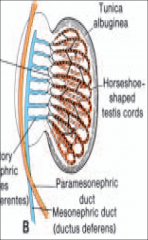
antimullerian hormone.
|
|
|
Antimullerian hormone inhibits the ______________ ducts which then degenerate around the __week of development.
|
paramesonephric
9th |
|
|
|
The seminiferous cords remain solid until puberty at which time a lumen develops and they become the =
|
seminiferous tubules.
|

|
|
|
■Gonadal cord
(mesothelium ,mesenchyme, primordial GC) |
■Gonadal cord
seminiferous cords develop tubuli recti, rete testis |
|
|
|
The rete testis becomes continuous with 15 to 20 mesonephric tubules that become =
|
efferent ductules (ductuli efferentes)
|
|
|
|
►These ductules are connected with the mesonephric duct, which becomes the =
|
duct of the epididymis.
|
|

